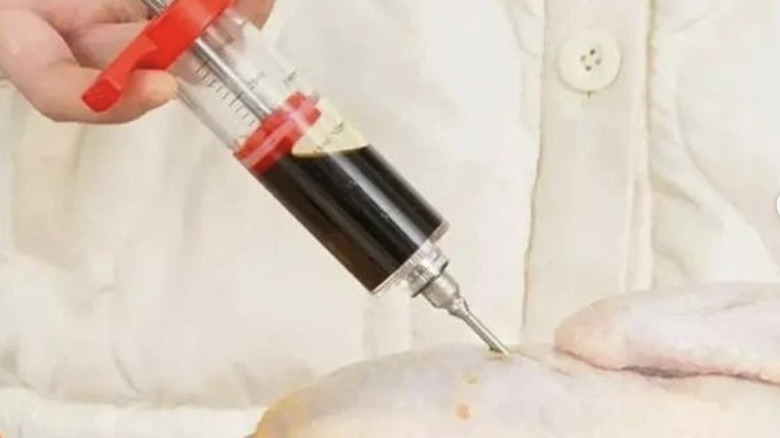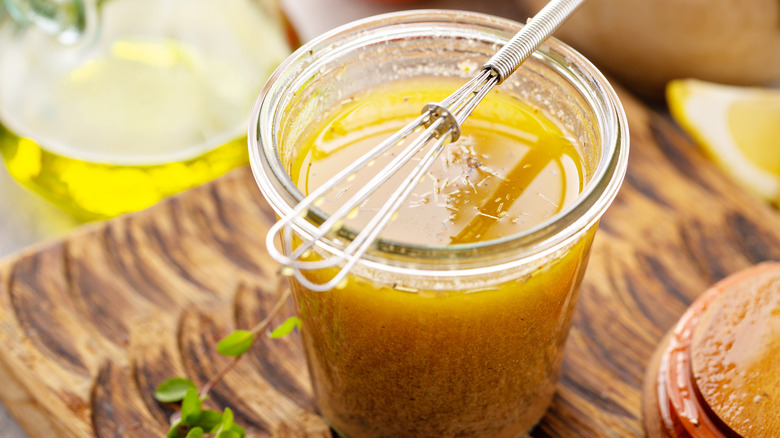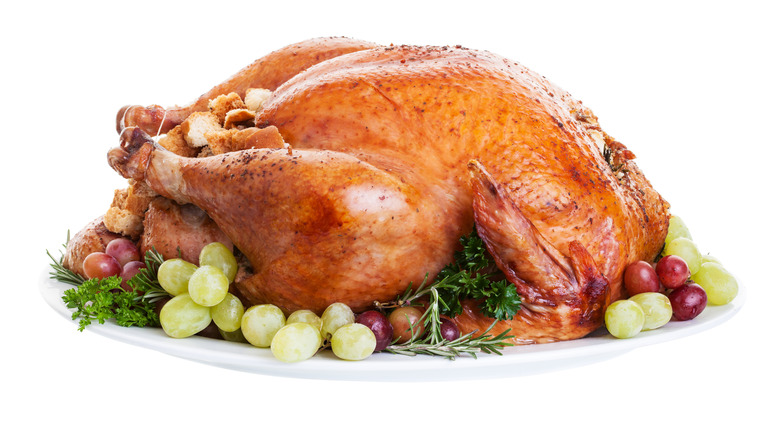What Is A Flavor Injector And How Does It Work?
In many ways, the term "flavor injector" is just what it sounds like: an implement for injecting flavor into your food before cooking. But in reality, it's not as simple as that. First, you need the right kind of flavor and consistency to get that deliciousness where you want it to be. Then, it takes a very specific tool and the proper technique. Fortunately, both are easy to come by.
In the culinary world, a flavor injector is an oversized syringe capable of holding liquid marinades, equipped with a needle tip through which the liquid travels into meats, like steaks, poultry, roasts, pork chops, hams, and more. Rather than just basting and soaking marinade sauce from the outside, this method gets that juiciness directly inside the meat prior to grilling, smoking, baking, air frying, or broiling.
A flavor injector really excels with high-heat cooking methods, as it helps retain moisture from the inside out, allowing a crispy exterior without drying out the interior meat. It also lets that marinade flavor bubble and brew deep inside, infusing every bite.
The process tenderizes the meat as well, particularly when using an acidic marinade made with ingredients such as vinegar, lemon, wine, apple cider, tomatoes, or citrus juices. These types of marinades break apart amino acids and "denature" meat proteins, leading to more tender meat, explains the Science Learning Hub. When mixed with oils and flavor, they slide right through the injector and into your upcoming dinner.
How to choose a flavor injector
Even if you've never used an injector in the kitchen, there's a fairly good chance you've seen or experienced injections for medical purposes. A culinary flavor injection is similar but way more fun — and scrumptiously tasty. The process is very simple, but you do need to consider a few things.
The consistency of a marinade sauce determines the type of flavor injector you need. A standard-sized injector needle works fine for simple oil or juice-based marinades and finely ground spices, but you'll need a large-gauge needle with a wider tip for thicker sauces, salad dressings, melted butter with herbs, or any marinade containing chunky bits like onions, garlic, or dried peppers. A thicker needle also stands up to thick or tough cuts of meat.
The syringe portion of a flavor injector comes in various sizes, so take into account meal portions and your preference for heavy or light marination. Larger syringes typically hold about two ounces of marinade, so if you're buying a single injector rather than a set with multiple sizes, go for the large one. You can always fill it halfway for a smaller portions or light marinades.
Finally, consider the construction of your injector, particularly the material composition of the syringe. Plastic versions cost less and are dishwasher-friendly, but they can also absorb odors and colors from the sauces and may need to be replaced more often. The alternative is a stainless steel injector, which is typically more durable, won't retain flavors, and is less likely to harbor bacteria.
Slide that needle in and get cooking!
Once you've sorted out the type of marinade and the most well-suited injector size, it's time to get that flavor where it needs to be. Flavor injecting is very straightforward – you're basically filling the syringe portion with liquid marinade, sliding the needle into the meat, and plunging/expressing the liquid deep into the meat interior. But the cut of the meat matters, as does the technique.
Napoleon suggests guiding the needle in horizontally for thin cuts of protein such as chicken, sliced steaks, or pork chops. If cooking large, thick meats such as a roast, turkey, or ham, make deep plunges all over the piece, taking care to avoid any bones. You don't want bones to splinter and cause an eating hazard.
Repeat the injections in multiple areas to ensure even distribution of the liquid. Some chefs and grill-masters recommend slowly pulling out the needle while pushing in the liquid, but stopping before a complete withdrawal. Then simply change the angle and continue until the liquid is fully dispensed. This limits the number of holes in the meat, and consequently, the number of air pockets that could release that luscious liquid during the cooking process.
You definitely want that marinade inside the meat, flavoring and tenderizing your meal to its ultimate melt-in-your-mouth potential.


